Call Center Contact Center Evolution and Its Impact on Customer Service

Imagine a customer waiting on hold, frustrated by slow responses and repeated questions. The evolution from traditional call centers to the modern Sobot call center contact center has transformed this experience. Today, 71% of businesses use digital channels for first contact, while 62% of agents report that easier access to customer data through Sobot AI enables more personalized service. Customers expect quick resolutions, with 65% preferring tailored communication through their chosen channels. Companies are witnessing a shift in support channels, as illustrated below:
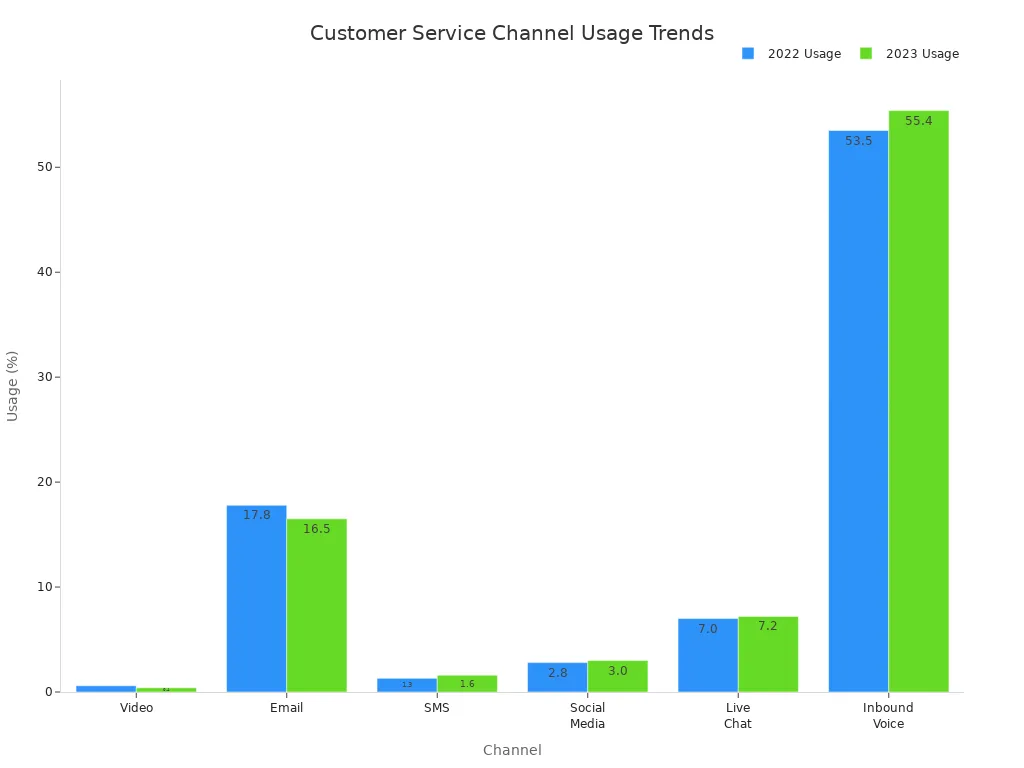
With Sobot and Sobot AI, the call center contact center landscape now delivers faster, more personalized customer experiences. Businesses that embrace the Sobot call center transformation can enhance service quality, boost customer satisfaction, and streamline their operations.
Call Center vs Contact Center

Definitions
Call centres have long served as the backbone of customer service, focusing on handling inbound and outbound voice calls. These centers rely on agents skilled in voice communication, using basic telephony systems and sometimes simple IVR menus. In contrast, contact centers represent a modern evolution. Contact centers support multiple communication channels, including phone, email, live chat, social media, and SMS. Agents in contact centers manage interactions across these platforms, using advanced technology like AI chatbots, CRM integrations, and automation tools.
Key Differences
| Aspect | Contact Centers | Call Centers |
|---|---|---|
| Communication Channels | Multiple: voice, email, live chat, social media, SMS, etc. | Primarily voice calls |
| Technology | Advanced: AI chatbots, CRM, automation, analytics | Basic telephony, IVR |
| Customer Engagement | Personalized, multichannel, data-driven | Limited personalization, voice only |
| Agent Skills | Versatile, multitasking, digital etiquette | Voice communication focused |
| Scalability | High, agents handle multiple interactions | Lower, one-on-one calls |
| Analytics | Advanced, cross-channel | Limited to call metrics |
| AI & Automation | Extensive use | Minimal use |
| Self-Service Options | Portals, chatbots, databases | Manual IVR only |
| Integrations | CRM, databases, business systems | Limited |
Contact centres enable agents to multitask and deliver consistent service across all channels. This flexibility allows contact centers to scale quickly and adapt to changing customer needs. Modern contact centers also use AI to automate routine tasks, reducing agent workload and improving efficiency.
Customer Service Impact
Call centre contact centre evolution has transformed customer service. Traditional call centres often struggle with long wait times, agent fatigue, and limited personalization. Contact centers address these pain points by integrating AI-powered knowledge management and CRM systems. These tools provide agents with real-time customer data, enabling faster and more personalized responses. Contact centers track a wide range of metrics, such as CSAT, NPS, and CES, across all channels. This comprehensive view helps identify gaps and improve service quality. Companies that upgraded from call centers to contact centers have seen first call resolution rates rise to 85% and operational costs drop by up to 50%. Consistency across channels remains crucial, as 75% of customers expect seamless experiences, and 73% may switch providers if expectations are not met. The shift from call centre to contact centre models delivers better customer engagement, higher satisfaction, and greater operational efficiency.
Call Centers: Early Development
1960s–1980s Milestones
The early history of call centres began in the 1960s. Companies installed Private Automated Business Exchanges (PABX) to manage customer contacts efficiently. In the United Kingdom, Birmingham Press and Mail became one of the first organizations to use PABX systems for handling large volumes of calls. The 1970s saw the introduction of telephone booking systems and the popularization of telephone headsets, inspired by NASA’s Mission Control. These advances allowed call centers to expand into telephone sales, airline reservations, and banking. By 1983, the term "call center" appeared in the Oxford English Dictionary, marking its official recognition. The 1980s brought toll-free telephone numbers, which improved agent efficiency and increased call volumes. Deregulation of long-distance calling and the growth of information-dependent industries fueled the rapid expansion of call centres worldwide.
Technology Foundations
Call centres relied on several key technologies during their early years. PABX systems formed the backbone, connecting rows of agents to incoming calls. The Galaxy Automatic Call Distributor (GACD), patented by Rockwell International, automated call routing and improved response times. Telephone headsets became standard equipment, freeing agents’ hands and increasing comfort during long shifts. Toll-free numbers made it easier for customers to reach businesses, boosting the popularity of call centers. These foundational technologies set the stage for the rise of virtual call centers, which would later use digital networks to connect agents across locations.
Limitations
Despite these advances, early call centres faced significant challenges. Managing fluctuating call volumes proved difficult, often resulting in long wait times and high customer abandonment rates when waits exceeded two minutes. Overstaffing raised operational costs by up to 25%, while understaffing led to agent burnout and reduced service quality. Predicting spikes in demand remained a challenge. Consistent service quality was hard to maintain due to differences in agent skills and experience. The lack of real-time monitoring and advanced workforce management tools limited operational efficiency. Outsourced call centers often relied on scripted responses, reducing personalized interactions and lowering customer satisfaction. Standardized processes restricted customization, making it hard for businesses to adapt to unique needs. These limitations highlighted the need for more flexible, scalable solutions, paving the way for the development of virtual call centers and modern contact center technology.
Contact Center Evolution
Multichannel Integration
Contact center evolution has shifted the industry from voice-only call centers to platforms that support multiple communication channels. Modern contact centers integrate phone, email, live chat, social media, and SMS, allowing customers to choose their preferred method of communication. This multichannel approach enables agents to manage interactions seamlessly, improving both customer service and operational efficiency.
Agents in contact centers access integrated customer data, which provides a comprehensive view of each customer's interaction history. This integration reduces the need for customers to repeat information, leading to quicker response and resolution times. AI-powered chatbots and virtual assistants handle routine inquiries instantly, directing customers to the right agent or self-service resource. Personalization is enhanced by analyzing customer behavior and history, tailoring recommendations and responses to individual needs.
The following table highlights key benefits of multichannel integration in contact centers:
| Benefit | Explanation |
|---|---|
| Integrated Customer Data | Agents access comprehensive customer interaction history enabling personalized service. |
| Quicker Response & Resolution | Ready access to data reduces customer repetition and speeds up issue resolution. |
| Improved Agent Productivity | Agents save time by avoiding switching between systems, focusing more on customer interaction. |
| Better Customer Service | Personalized experiences increase satisfaction and loyalty. |
| Channel Flexibility | Easy integration of new channels without data silos enhances customer engagement options. |
Contact centers that leverage multichannel integration report a 23% increase in agent productivity and a significant reduction in time to resolution. Conversations continue across channels with minimal customer effort, improving engagement and satisfaction. Real-time data analytics help identify pain points, optimize agent performance, and enable proactive customer support. Companies using unified contact center platforms experience lower operational costs and higher customer loyalty, driving revenue growth.
Omnichannel Solutions
Omnichannel call centers represent the next stage in contact center evolution. These platforms unify all communication channels, preserving the context of customer interactions across phone, chat, email, and social media. Customers can switch between channels without repeating information, reducing frustration and enhancing the overall customer experience.
Omnichannel contact centers use AI and automation to route inquiries intelligently, ensuring customers reach the right agent or self-service resource quickly. Agents have unified access to customer data and interaction history, enabling personalized and informed responses. Standardized messaging and tone across channels ensure a consistent brand experience and compliance with regulations.
Omnichannel experience delivers seamless, consistent customer journeys, fostering trust and loyalty.
Key features of omnichannel contact centers include:
- Consolidation of customer data from all channels, giving agents full visibility into prior interactions.
- Standardization of messaging and tone across platforms, improving service quality and regulatory compliance.
- AI-powered tools supporting intelligent routing and personalization, increasing agent productivity and customer satisfaction.
- Companies with strong omnichannel engagement retain significantly more customers, demonstrating improved experience quality.
Omnichannel call centers distinguish themselves from multichannel centers by enabling frictionless customer journeys. The integration of channels allows customers to continue conversations seamlessly, enhancing consistency and reducing customer friction. Operational efficiency improves as agents handle more interactions with less effort, and customer support teams report higher satisfaction rates.
Sobot’s Role
Sobot has emerged as a leader in omnichannel contact center solutions, driving the evolution of customer service across industries. Sobot’s omnichannel platform integrates voice, chat, email, social media, and WhatsApp, providing a unified workspace for agents and administrators. The solution leverages AI-driven automation to handle up to 70% of customer interactions without human intervention, freeing agents to focus on complex and emotional issues.
Sobot’s omnichannel solution offers several advanced features:
| Feature/Aspect | Description | Impact on Customer Service Efficiency and Satisfaction |
|---|---|---|
| Generative AI | AI-driven virtual agents handling up to 70% of customer interactions without human intervention | Improves customer satisfaction by 30%; reduces workload on human agents |
| Real-time Analytics | Analyzes vast data to predict customer needs and respond quickly | Enables proactive engagement and faster response times |
| Cross-channel Data Integration | Integrates data from email, social media, phone, in-store for seamless experience | Creates cohesive customer journeys, increasing loyalty and retention |
| Emotion-aware Chatbots | Uses NLP to detect customer sentiment and adapt responses | Enhances empathy in interactions, improving customer experience and de-escalating issues |
| AI-powered Voice Assistants | Recognizes emotional cues in voice to tailor responses | Provides more personalized and empathetic support |
| Human-AI Collaboration Model | AI handles routine queries; humans focus on complex, emotional issues | Increases agent productivity and customer retention by 91% year-over-year |
| Operational Efficiency | AI reduces resolution times by up to 50%, first response times by 37%, and staffing needs | Leads to significant cost savings and faster problem resolution |
| Customer Feedback | 80% of customers report positive experiences with AI-powered service | Reflects increased satisfaction and loyalty |
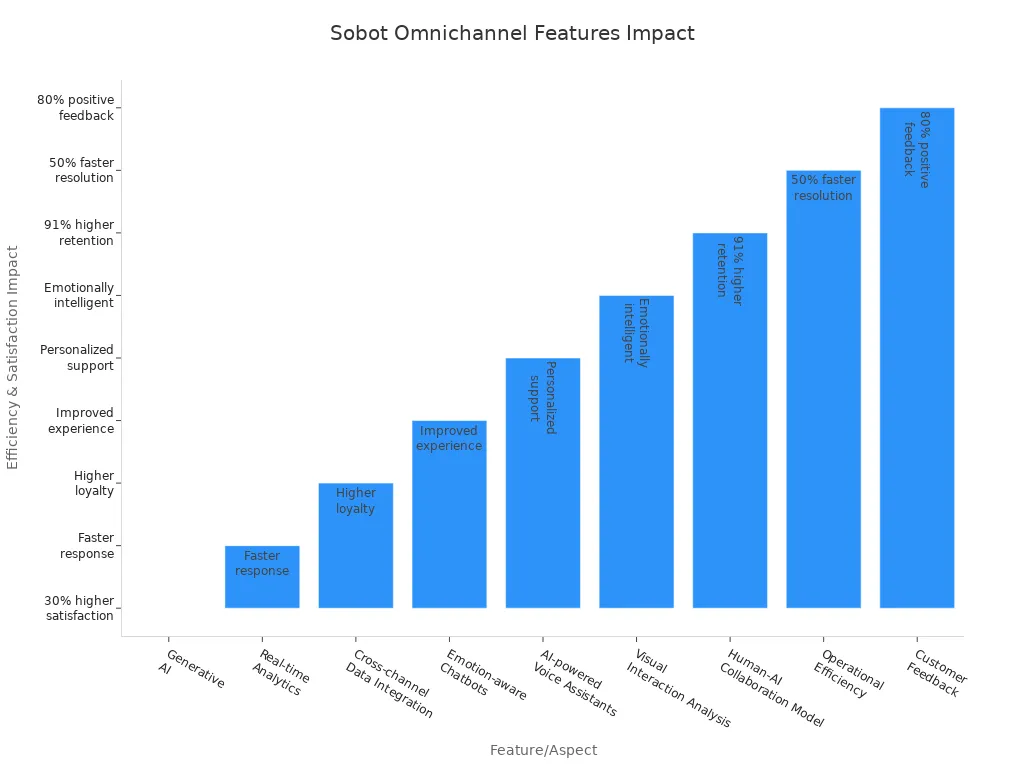
Sobot’s omnichannel contact center solution supports a wide range of industries, including retail, financial services, gaming, education, and enterprise services. In retail and e-commerce, Sobot integrates platforms like Shopify and Amazon, enabling conversational AI to engage shoppers throughout their journey. This approach resolves 70% of inquiries and increases conversion rates by three times. Financial services benefit from Sobot’s no-code contact center platform, which blends AI and human expertise to handle FAQs on interest rates and loan eligibility, while prioritizing data privacy and compliance with ISO and GDPR standards.
Customer success stories highlight Sobot’s impact. OPPO, a leading smart device manufacturer, implemented Sobot’s chatbot and ticketing system to manage high volumes of customer inquiries during peak shopping periods. The integration allowed OPPO to achieve an 83% chatbot resolution rate, a 94% positive feedback rate, and a 57% increase in repurchase rate. J&T Express boosted its sign-off rate by 35% and cash-on-delivery collection by 40% after adopting Sobot’s omnichannel solution. These results demonstrate strong operational and customer experience improvements across industries.
| Industry | Use Case Highlights | Key Benefits and Metrics |
|---|---|---|
| Retail & E-commerce | Integration of multiple e-commerce platforms into one omnichannel contact center. Conversational AI engages shoppers throughout their journey. | Resolves 70% of inquiries; increases conversion rates by 3x. |
| Financial Services | No-code contact center platform blending AI and human expertise to handle FAQs. Prioritizes data privacy and compliance. | Fast, secure customer experience transformation; ensures regulatory compliance. |
| Customer Success Stories | Companies like OPPO, J&T Express, SHEIN, Weee!, MICHAEL KORS, and Transsion have implemented Sobot solutions. | OPPO achieved 93% CSAT; J&T Express boosted sign-off rate by 35% and COD collection by 40%. |
| Overall Performance Metrics | ROI of 234%, 60% reduction in agent workload, 15% increase in conversion rate, 35% improvement in NPS, resolution time under 1 minute with AI + human workflows. | Demonstrates strong operational and customer experience improvements across industries. |
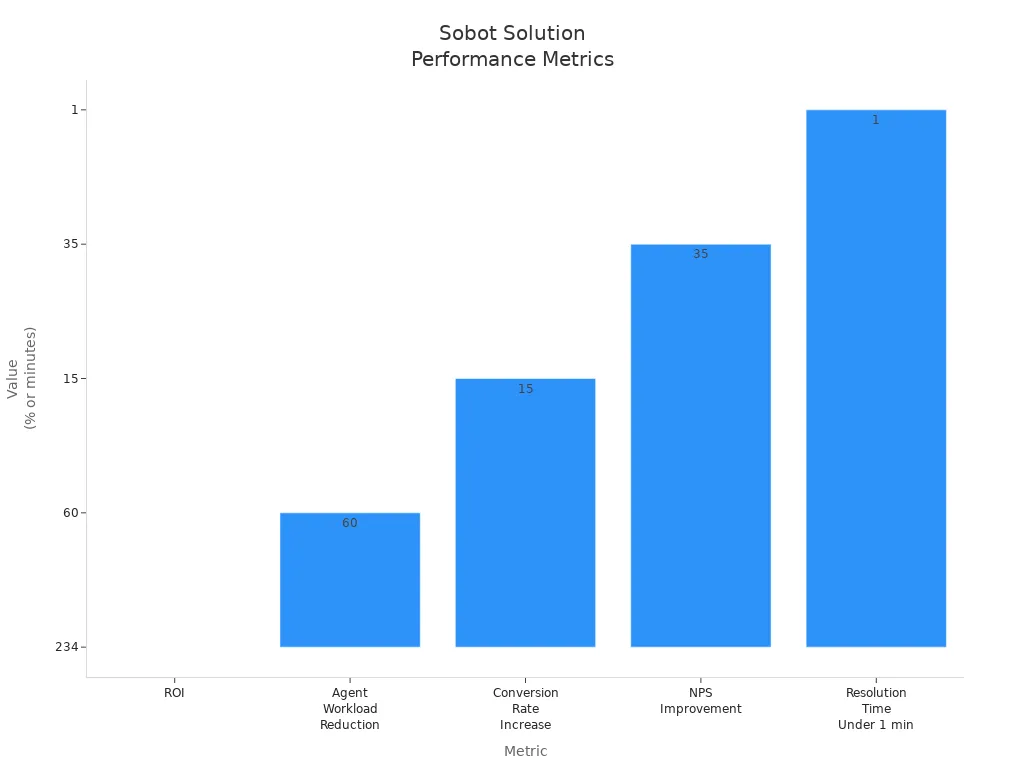
Sobot’s platform delivers measurable improvements in customer service metrics. Companies report up to a 50% reduction in resolution time, a 68% decrease in staffing needs during peak seasons, and approximately 80% positive customer feedback with AI-powered support. First response times improve by 37%, and operational costs decrease significantly. These enhancements reflect Sobot’s commitment to innovation, customer-centricity, and efficiency, as outlined on the official Sobot website.
Technology and innovation play a central role in shaping customer experiences within contact centers. Customers now expect highly personalized experiences, with 89% demanding personalization according to Gartner. Advanced technologies like AI, chatbots, and data analytics transform contact centers from support hubs into strategic assets that drive revenue and loyalty. AI and automation reduce wait times and streamline issue resolution, enabling agents to focus on empathetic and creative tasks. Contact centers leverage data insights from customer interactions to improve products, marketing, and overall business strategy. Omnichannel engagement through phone, chat, email, social media, and video meets customer preferences and enhances convenience. Continuous feedback collection via contact centers supports ongoing improvement in customer experience.
Sobot’s omnichannel contact center solution exemplifies the evolution of customer service, delivering faster, more personalized, and consistent experiences across all channels. Businesses that adopt Sobot’s platform gain a competitive advantage, improve customer satisfaction, and optimize operational efficiency. The future of customer support lies in intelligent, omnichannel call centers that prioritize seamless customer journeys and real-time engagement.
Modern Call Center Contact Center Technologies
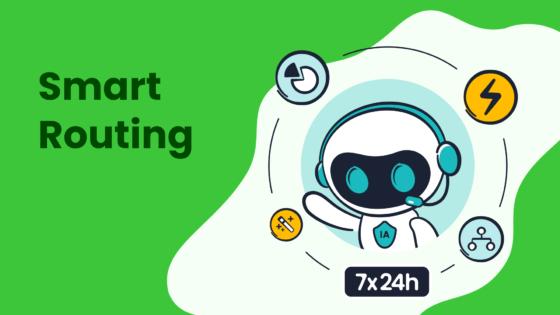
Cloud and AI
Modern call centers and contact center platforms now rely on cloud and AI technologies to deliver scalable, flexible, and intelligent customer service. Cloud-based contact center solutions allow organizations to adjust operations quickly during demand spikes, reducing capital investment and operational costs. AI-driven speech recognition and voice AI enable real-time transcription, multilingual support, and automated compliance monitoring. Natural Language Processing (NLP) and Machine Learning (ML) automate quality assurance scoring and personalize routing, improving service speed and accuracy. Sentiment analysis detects customer emotions, allowing agents to respond with empathy and escalate issues proactively. These advancements increase scalability, reduce agent workload, and improve first-call resolution rates. Modern call centers also benefit from AI-powered analytics, which extract actionable insights on agent performance and customer behavior, leading to smarter operations and higher productivity.
- AI-driven workforce management predicts call volumes and optimizes agent schedules.
- Real-time agent assistance provides instant recommendations, reducing decision fatigue.
- Speech recognition makes calls searchable and actionable for supervisors.
Automation
Automation has become a cornerstone of contact center efficiency. Real-time AI automates routine tasks, allowing agents to focus on complex interactions. AI-powered call routing matches customers with the best-suited agents, improving first-call resolution and reducing wait times. Integration with CRM systems gives agents detailed customer history, enabling tailored service and increasing loyalty. Quality assurance improves through AI-driven call scoring and transcript analysis, supporting better agent training. Studies show automation in contact centers boosts agent productivity by 20%, reduces operational costs by up to 30%, and increases customer satisfaction by 25%.
| Aspect | Impact of Automation | Supporting Data / Source |
|---|---|---|
| Agent Productivity | Automation handles routine tasks, freeing agents to focus on complex issues, improving productivity by 20%. | Everest Group, 2021 |
| Cost Savings | Automation reduces operational costs by up to 30%, through RPA and AI-driven self-service options. | IDC, 2020 |
| Customer Satisfaction | Faster issue resolution, personalized AI-powered interactions, and reduced wait times increase satisfaction by 25%. | Customer Contact Week Digital, 2021 |
| Additional Benefits | Real-time AI tools provide instant response suggestions, sentiment analysis, and intelligent call routing, enhancing both agent performance and customer experience. | Multiple sources |
Sobot Voice/Call Center

Sobot Voice/Call Center stands out in the contact center industry by combining advanced AI-powered voicebot technology, a unified workspace, and global telephony capabilities. The AI-powered voicebot uses ASR, NLP, and TTS to handle inbound and outbound calls independently, transferring to human agents when needed. This feature automates over 50% of customer interactions, demonstrating high efficiency. The unified workspace integrates chat, email, voice, and social media channels, providing agents with a seamless experience and superior omnichannel coverage. Scenario-based AI supports industries like e-commerce and retail, enhancing customer satisfaction and sales throughout the purchase journey. Sobot’s multi-faceted AI roles include AI Agent for customer-facing tasks, AI Copilot for agent assistance, and AI Insight for administrator dashboards, optimizing operations beyond typical AI agents. Secure AI ensures data privacy and compliance with global regulations. Outbound AI agents drive sales growth by automating marketing campaigns, improving results by over 30%. Sobot’s technology reduces customer service costs by 30%, resolves tickets 52% faster, and boosts agent productivity by allowing human agents to focus on complex tasks. Organizations using Sobot Voice/Call Center report increased CSAT scores, reduced response times, and scalable, efficient customer service ecosystems.
Learn more about Sobot Voice/Call Center features at Sobot Voice/Call Center.
Customer Success Stories
OPPO and Sobot
OPPO, a global leader in smart devices, faced growing demands from customers during peak shopping periods. The company partnered with Sobot to transform its customer service operations. Sobot introduced an AI-powered chatbot and a ticketing system, allowing OPPO to handle high volumes of inquiries efficiently. The chatbot resolved 83% of customer questions without human intervention. This high resolution rate led to a 57% increase in repurchase rates, showing a direct link between efficient support and customer loyalty. OPPO’s experience highlights how advanced technology can deliver an improved customer experience and support business growth.
Measurable Results
Organizations that implement Sobot’s solutions report significant gains in customer service metrics. AI-powered automation reduces response times by up to 95% and increases customer satisfaction by 25%. Staffing needs during busy seasons drop by as much as 68%. Companies see a 30% improvement in first-contact resolution and a 13.8% rise in customer inquiries handled per hour. The following table summarizes key improvements:
| Metric | Before Automation | After Automation | Improvement |
|---|---|---|---|
| First Response Time | 15 minutes | 2 minutes | 86.7% reduction |
| Resolution Time | 60 minutes | 30 minutes | 50% reduction |
| Customer Satisfaction (CSAT) | 75% | 85% | 13.3% increase |
| Resolution Rate | 60% | 80% | 33.3% increase |
| Escalation Rate | 20% | 5% | 75% reduction |
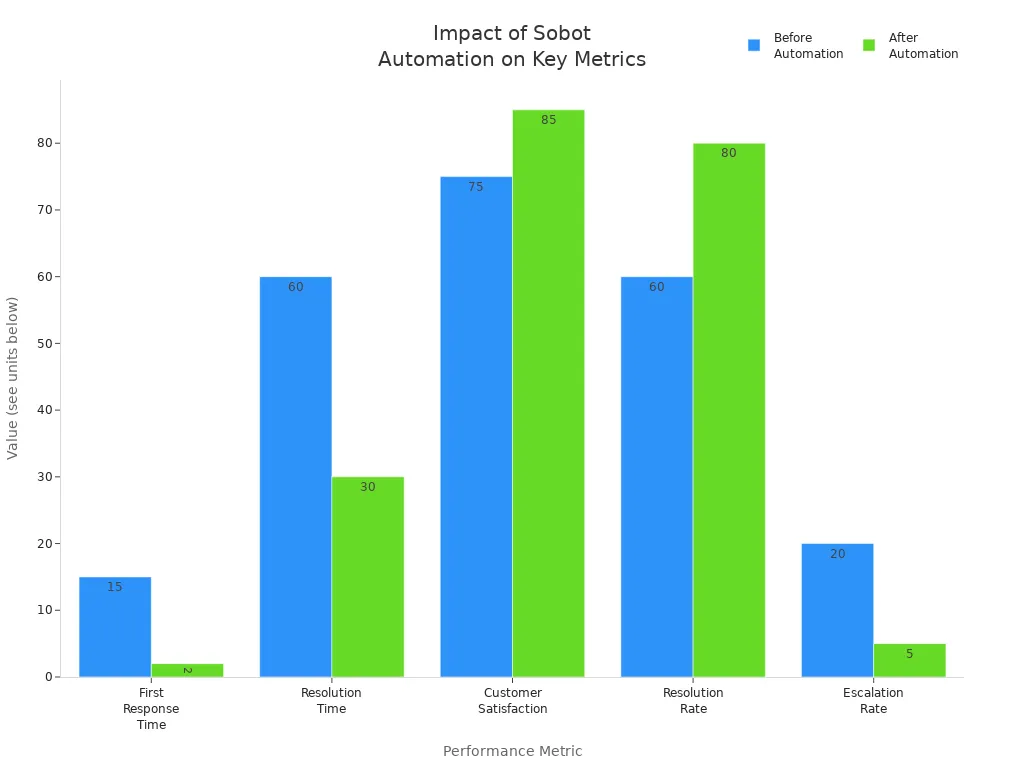
These results show that Sobot’s technology helps customers achieve faster resolutions, higher satisfaction, and more efficient operations.
Lessons Learned
Companies using Sobot’s solutions have learned several important lessons:
- Understanding chatbot technology helps set realistic goals and scope.
- Chatbots work best as partners to human agents, not replacements.
- Each organization must adapt chatbot use to its unique needs and sector.
- Continuous AI training and content updates are key for success.
- Effective strategies balance multiple chatbot tools before settling on the best fit.
These lessons guide organizations to create flexible, customer-focused service strategies. Sobot’s approach empowers customers and agents, leading to lasting improvements in customer service.
Future of Call Centres
Trends
The future of call centres will see rapid changes as technology and customer expectations evolve. Many organizations now use hybrid models, combining physical offices with virtual call centers. This approach increases flexibility and allows companies to hire skilled agents from different locations. Remote operations have become common, helping call centers maintain business continuity during crises.
A digital-first mindset shapes the future of omnichannel customer service. Automation, AI, and cloud systems improve efficiency and satisfaction. Call centres expand self-service options, such as smart IVRs and chatbots, to handle routine questions. This lets agents focus on complex problems. Security policies also change, with more companies using VPNs and private clouds to protect data.
Key trends include:
- Intelligent routing connects callers to the best agent, reducing wait times.
- Video chat and screen sharing help agents solve problems faster.
- Cloud-based call centers lower costs and allow for more personalized service.
- AI and robotic process automation handle routine tasks, freeing agents for important work.
- Mobile optimization and CRM integration make it easier for customers to get help on any device.
- Voice biometrics improve security by using unique voiceprints.
- The Internet of Things (IoT) allows devices to request support before customers notice issues.
- 5G technology promises better call quality and supports remote workforces.
Challenges
Call centres face several challenges as they adopt new technologies. Integrating AI can be complex, especially when balancing emotional cues and agent well-being. Some companies use AI to soften the tone of angry customers, reducing stress for agents. Cybersecurity remains a top concern. With more sensitive data handled by call centers, protecting customer information is critical. Voice biometrics help, but threats continue to grow.
Customer expectations rise every year. People want proactive, personalized, and always-on service. Call centres must use data analytics to predict needs and respond quickly. Unified agent desktops, advanced IVR, and generative AI chatbots help reduce agent workload and improve customer experience. However, keeping up with these changes requires ongoing investment and training.
Opportunities
Advancements in contact center technology create many opportunities for businesses. AI-driven personalization predicts customer behavior and tailors each interaction. Integrated omnichannel support ensures seamless experiences across phone, chat, email, and social channels. Real-time analytics help managers make better decisions and optimize operations.
Remote and hybrid work models expand the talent pool and keep agents engaged. Strong cybersecurity builds trust with customers. Companies that adapt quickly to new technologies can stand out from competitors. AI and conversational tools improve self-service and make interactions more human-like. By integrating systems like CRM and call interfaces, call centres increase agent productivity and reduce repetitive tasks.
Contact centers now act as profit centers, using AI and analytics to find new business insights. Cloud-based solutions offer scalability and cost savings. These changes lead to faster resolutions, more personalized service, and higher customer satisfaction. The future of call centres will focus on creativity and innovation, making it easier for agents to solve unique customer problems and deliver great experiences.
The shift from call centers to contact centers has transformed customer service. Sobot’s AI-powered solutions deliver multichannel support, skill-based routing, and cloud-based efficiency. Businesses now resolve issues faster and personalize every interaction.
| Key Improvement | Customer Service Impact |
|---|---|
| Multichannel & Omnichannel Support | Seamless experience, faster resolution |
| AI Automation & Routing | Reduced wait times, higher satisfaction |
| Cloud Integration | Flexibility, cost savings |
Organizations should upskill agents, integrate omnichannel platforms, and balance AI with human empathy. Industry experts predict intelligent, human-centric contact centers will define the future of customer engagement.
FAQ
What is the difference between a call center and a contact center?
A call center handles only voice calls. A contact center manages customer interactions across multiple channels, including phone, email, chat, and social media. Sobot’s contact center solution supports seamless communication on all platforms.
How does Sobot improve customer service in a contact center?
Sobot uses AI-powered automation, unified workspaces, and omnichannel support. These features help agents resolve issues faster, personalize responses, and increase customer satisfaction. Companies report up to 50% faster resolution times with Sobot.
Can Sobot’s call center contact center integrate with existing business systems?
Yes. Sobot offers simple integration with CRM, e-commerce, and other business platforms. This allows agents to access customer data instantly and provide better service. Integration supports global operations and secure data transfer.
What industries benefit most from Sobot’s call center contact center solutions?
Retail, financial services, gaming, education, and enterprise services see strong results. Sobot’s platform adapts to industry needs, improving efficiency and customer loyalty. OPPO and J&T Express achieved higher satisfaction and faster service using Sobot.
How does Sobot ensure data security in its call center contact center platform?
Sobot uses encrypted data transfer, secure cloud infrastructure, and compliance with global standards like ISO and GDPR. These measures protect customer information and maintain trust across all channels.
Tip: For more details on Sobot’s call center contact center solutions, visit Sobot’s official website.
See Also
Best Cloud-Based Contact Center Services Evaluated For 2024
Effective Strategies For Managing Call Center Quality
Leading Contact Center Technologies Assessed For 2024
How To Deploy Omnichannel Contact Center Solutions Successfully
Artificial Intelligence Transforming Customer Service Support Today
